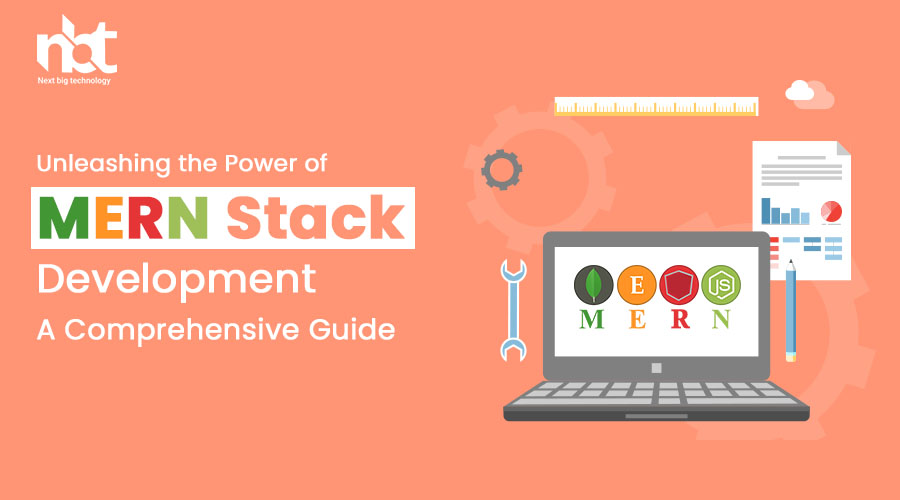Introduction: In the world of web development, MERN stack has emerged as a powerful and popular choice for building robust and dynamic web applications. MERN, an acronym for MongoDB, Express.js, React.js, and Node.js, is a full-stack JavaScript framework that enables developers to create seamless and scalable applications. In this blog, we will explore the power of MERN stack development and how it empowers developers to build modern and efficient web applications.
- MongoDB: Scalable and Flexible Database At the heart of the MERN stack is MongoDB, a highly flexible and scalable NoSQL database. MongoDB allows developers to store and manage data in a JSON-like format, making it easy to work with complex data structures. With its document-based model, MongoDB offers a high degree of scalability, allowing applications to handle large volumes of data effortlessly. Its flexible schema enables developers to make changes to the database schema on the go, without any downtime or disruptions.
- Express.js: Fast and Efficient Web Application Framework Express.js, a minimalist web application framework, serves as the backend component of the MERN stack. Built on top of Node.js, Express.js provides developers with a simple yet powerful framework for building web APIs and handling server-side logic. It offers a wide range of middleware options, routing capabilities, and template engines, making it highly customizable and efficient for developing web applications. Express.js allows seamless integration with other Node.js libraries and tools, enhancing development productivity.
- React.js: Interactive and Dynamic User Interfaces React.js, a JavaScript library developed by Facebook, is a key component of the MERN stack for building dynamic user interfaces. React.js leverages a component-based architecture, enabling developers to build reusable UI components that can be combined to create complex user interfaces. Its virtual DOM (Document Object Model) allows for efficient rendering and updating of UI elements, resulting in faster and more responsive applications. React.js also facilitates the development of single-page applications (SPAs), enhancing the user experience by reducing page reloads.
- Node.js: Scalable and Asynchronous Backend Node.js, the runtime environment for JavaScript, completes the MERN stack by serving as the backend server platform. Node.js offers a non-blocking, event-driven architecture, making it highly efficient for handling concurrent requests and building scalable applications. Its rich ecosystem of libraries and modules enables developers to easily integrate third-party services and APIs into their applications. With the ability to handle real-time communication and perform server-side tasks, Node.js provides a robust foundation for MERN stack applications.
- Full JavaScript Stack: Seamless Integration and Code Reusability One of the major advantages of the MERN stack is its full JavaScript stack, where developers can write both the frontend and backend code in JavaScript. This allows for seamless integration and code reusability, as developers can share code and logic between the client-side and server-side components. With a unified language and development environment, the MERN stack simplifies the development process and promotes efficient collaboration between frontend and backend developers.
- Rapid Prototyping and Development Efficiency The MERN stack facilitates rapid prototyping and development efficiency, enabling developers to build applications quickly and iterate on them effectively. The combination of MongoDB’s flexible schema, Express.js’ lightweight framework, React.js’ component-based approach, and Node.js’ scalability empowers developers to develop, test, and deploy applications rapidly. The modular nature of the MERN stack components allows for easier debugging, testing, and maintenance of the application codebase.
- Robust Community Support and Ecosystem The MERN stack benefits from a thriving and robust open-source community, with numerous libraries, frameworks, and resources available. Developers can leverage the extensive ecosystem to find solutions, address challenges, and enhance their development process. From community-contributed packages on npm (Node Package Manager) to comprehensive documentation and tutorials, the MERN stack community offers valuable support and resources for developers at all skill levels.
- Scalability and Performance The MERN stack is well-suited for building scalable and high-performance web applications. With MongoDB’s horizontal scalability, Node.js’ non-blocking architecture, and React.js’ efficient rendering, MERN stack applications can handle increasing user loads and deliver optimal performance. Additionally, the ability to deploy MERN stack applications to cloud platforms like AWS or Heroku further enhances scalability and provides options for auto-scaling as per demand.
- Rich Ecosystem of Libraries and Tools The MERN stack benefits from a rich ecosystem of libraries and tools that complement its core components. Developers can leverage tools like Webpack and Babel for bundling and transpiling, Redux for state management, and Mongoose for MongoDB object modeling. These tools enhance the development experience, improve productivity, and provide additional features and functionalities to build robust and feature-rich applications.
- Cross-Platform Development and Code Reusability The MERN stack enables developers to build cross-platform applications, thanks to its use of JavaScript as the primary programming language. With frameworks like React Native, developers can leverage their existing MERN stack skills to build mobile applications for both iOS and Android platforms. This promotes code reusability and reduces the need for separate development efforts, leading to faster time-to-market and cost savings.
Conclusion: The MERN stack is a powerful and versatile framework for building modern web applications. With MongoDB’s scalability, Express.js’ efficiency, React.js’ interactivity, and Node.js’ asynchronous backend, the MERN stack empowers developers to create robust, scalable, and high-performing applications. The full JavaScript stack, rapid prototyping capabilities, extensive community support, and rich ecosystem of tools make the MERN stack a popular choice among developers. Whether you’re a seasoned developer or just starting your web development journey, exploring the power of the MERN stack can open up exciting possibilities for building cutting-edge web applications.

















